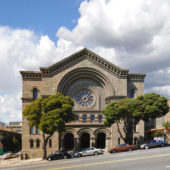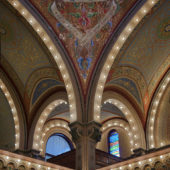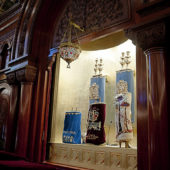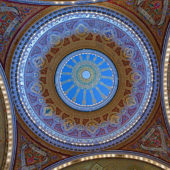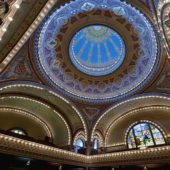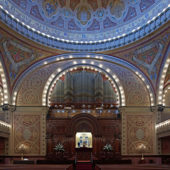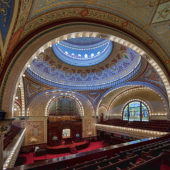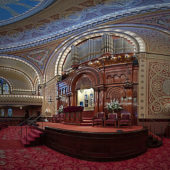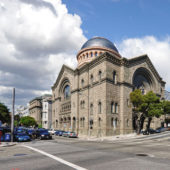Founded amid the exuberance of the California Gold Rush, the spacious and grand sanctuary’s soaring arches and domes are decorated with Byzantine motif frescoes.
Congregation Sherith Israel is one of the oldest in the western United States. This San Franciscan synagogue likens its history to that of its city’s history: the Gold Rush, fire, earthquake, scandal, war, another earthquake. Most of the early Jewish immigrants to San Francisco were fleeing Europe’s repressive regimes, pogroms, constrained employment, forced military conscription and restricted marriage. Enterprising Jews saw little future for themselves in Central Europe and therefore, when gold was discovered, California became their new Promised Land.
Some months after the discovery of gold in California, in September of 1849, a small group of Jewish pioneers began meeting in a wood-framed tent. Without a rabbi or Torah scrolls, the first Rosh Hashanah and Yom Kippur were celebrated in the San Francisco. This band of Jews came from Prussia, Bavaria, England, France and the eastern United States. They met again to celebrate Passover and the High Holy Days in 1850 and subsequently formed two benevolent societies to aid the needy. They also purchased land for a cemetery. In April 1851 the Jewish community met again, this time to form a permanent congregation and elect officers. However, they split almost immediately, forming two synagogues: Congregation Sherith Israel (following Polish traditions of Jews from Posen in Prussia) and Congregation Emanu-El (worshipping according to the German rite of Jews from Bavaria). The synagogues have continued to be friendly since the original split.
Congregation Sherith Israel’s first temporary home was destroyed by the ‘Great Fire of 1851.’ Its next home was similarly lost to a fire. The congregation then built its own house of worship in 1854 for $10,000. There was such a huge exodus of Jews from Europe that by the end of the 1850s, ten percent of the San Francisco’s population was Jewish (briefly a higher percentage than in New York!). Following the Civil War, another wave of people moved into the city. With expanding Jewish population and membership, in 1870 Sherith Israel moved into an impressive, Gothic building, where it remained for 34 years.
Sherith Israel was initially Orthodox following the Polish traditions; however, it began taking major steps towards becoming a Reform congregation. Seating became mixed, evening services were initiated, a choir was introduced, a new prayer book was selected, etc. The congregation was to move yet once again. In 1903 construction began on the current site. The architect for the new building was Albert Pissis, who trained in Paris at L’Ecole des Beaux Arts. The synagogue is Byzantine Revivalist in style, as evidenced in the great dome capping the sanctuary (140 feet above California Street and 60 feet wide), the soaring arches, over 90 opalescent stained glass windows, more than 32 arched windows and elaborate stenciled frescoes. The 22,000 square foot prayer room seats 1,400 people. The bimah and pews are hand-carved from Honduran mahogany. The magnificent Murray Harris organ is recognized as an historic treasure of American organ building.
Two years after the new home for Sherith Israel was completed and consecrated. Congregation Sherith Israel officially joined the Union for Reform Judaism. In 1906, early on the morning of April 18, the Great Quake rocked San Francisco. Fires subsequently sprung up all over the city. Fortunately, the new synagogue sustained only modest damage, which was rapidly repaired. In 1989 a major earthquake struck the city. Although the synagogue was not damaged, the State of California mandated that the synagogue meet stringent seismic standards. The congregation pursued an ambitious capital campaign to meet those standards.
The rabbis who have served the congregation have been known for their positions on social justice, civil rights, human rights and even Soviet Jewry. Rabbi Goldstein was known for his doctorate and book, Jesus in the Jewish Tradition. Music has played an important part in the synagogue, and continues to do so. Today, the style of music is rotated weekly between the congregational choir and the Journey to Shabbat band. On High Holy Days, choral music is performed by famous composers, with instrumental accompaniment. The synagogue strategically plans for the future and its activities include: worship, education, membership, social action and synagogue governance. Interfaith families are welcome. This magnificent synagogue attracts visitors from all over the world.

